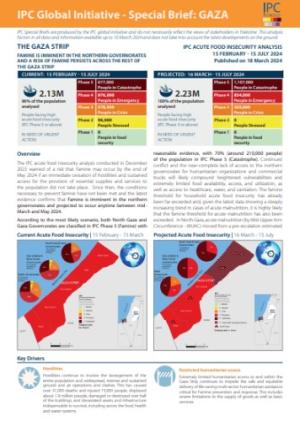The ongoing conflict in the Gaza Strip has led to a severe humanitarian crisis, exacerbating food insecurity and displacement. Nearly 80% of Gaza's population has been displaced, with conditions deteriorating since October due to the blockade and widespread infrastructure destruction, including hospitals, schools, and essential utilities. The World Food Programme's assessments during a temporary humanitarian pause indicated that food insecurity has significantly increased, driven by disruptions in food distribution, rising food prices, economic instability, and limited humanitarian aid. Notably, the majority of households in both northern and southern Gaza report poor food consumption levels, with many resorting to extreme coping strategies such as reducing meal sizes and number of meals to manage the scant food supplies available.
The situation has worsened, as recent data indicates that up to 93% of the population faces crisis-level or worse acute food insecurity, according to the Integrated Phase Classification (IPC). This alarming figure is a result of continued high-intensity conflict and displacement, particularly in the southern governorates. The IPC projections suggest a grim outlook, with significant portions of the population likely facing famine conditions in the coming weeks. The dire food security situation is compounded by the destruction of basic services and infrastructure, leading to heightened risk of disease and further complicating the delivery of much-needed humanitarian aid. Immediate actions, including a ceasefire and restoration of essential services, are critical to prevent a major human disaster and address the acute food insecurity affecting the vast majority of Gaza's population.
In this context, it is crucial to closely monitor the impact of the crisis on food security. Accordingly, this page offers a series of blogs dedicated to examining the Gaza Strip crisis, alongside interactive tools and charts designed to provide up-to-date information and insights into the evolving situation.
Photo credit: Wikimedia Commons
Gaza Strip: IPC Global Initiative - Special Brief

The IPC acute food insecurity analysis conducted in December 2023 warned of a risk that Famine may occur by the end of May 2024 if an immediate cessation of hostilities and sustained access for the provision of essential supplies and services to the population did not take place. Since then, the conditions necessary to prevent famine have not been met and the latest evidence confirms that Famine is imminent in the northern governorates and projected to occur anytime between mid-March and May 2024.
According to the most likely scenario, both North Gaza and Gaza Governorates are classified in IPC Phase 5 (Famine) with reasonable evidence, with 70% (around 210,000 people) of the population in IPC Phase 5 (Catastrophe). Continued conflict and the near-complete lack of access to the northern governorates for humanitarian organizations and commercial trucks will likely compound heightened vulnerabilities and extremely limited food availability, access and utilization, as well as access to healthcare, water, and sanitation. The famine threshold for household acute food insecurity has already been far exceeded and, given the latest data showing a steeply increasing trend in cases of acute malnutrition, it is highly likely that the famine threshold for acute malnutrition has also been exceeded. The upward trend in non-trauma mortality is also expected to accelerate, resulting in all famine thresholds likely to be passed imminently.
The southern governorates of Deir al-Balah and Khan Younis, and the Governorate of Rafah, are classified in IPC Phase 4 (Emergency). However, in a worst-case scenario, these governorates face a risk of Famine through July 2024.
The entire population in the Gaza Strip (2.23 million) is facing high levels of acute food insecurity. Between mid-March and mid-July, in the most likely scenario and under the assumption of an escalation of the conflict including a ground offensive in Rafah, half of the population of the Gaza Strip (1.11 million people) is expected to face catastrophic conditions (IPC Phase 5), the most severe level in the IPC Acute Food Insecurity scale. This is an increase of 530,000 people (92 percent) compared to the previous analysis.
Damaged agricultural lands in the Gaza strip
Israel’s continuing attacks against Hamas are causing massive collateral damage to agricultural livelihoods and food supplies in the Gaza Strip. More than one third of agricultural lands in Gaza have been damaged since the outbreak of the war on October 7, 2023, according to analysis based on satellite imagery by the United Nations Satellite Centre (UNOSAT) and the UN Food and Agriculture Organization (FAO).
